In late October 2017, Visions made a trip to Qusar, an area of northern Azerbaijan with a large Lezgin population, not to ski the snow-capped mountains or gaze across the border toward Russia but to look down at people’s feet. The Lezgin people are known not only for carpet making but also for knitting traditional jorabs, which are brightly patterned slipper socks.
To learn more, we teamed up with Teresa Hamlin, founder of Azerbaijani Socks – a small business that employs rural women to produce hand-knit socks that are sold online and in American shops. We met with some prodigious knitters, hoping to discover the secrets of this woollen art and why the Lezgins have cosied up to it for so long.
Where there is wool…
As we drive north to Qusar, the weather gradually grows cooler, and the mountains of the Greater Caucasus rise up in the distance. Why should this be the heartland of knitting? Clues start to emerge as we visit the homes of several women who knit for Azerbaijani Socks.
As with many traditions, each generation points to the previous one. One knitter and former professional carpet maker, Narmina, says, I know our ancestors have been making carpets and socks for at least 200 or 300 years… I learned this from my grandmother and mother.
Sevil, another knitter who sets her eyeglasses aside to serve us steaming blackcurrant tea in her sitting room, surmises, Lezgins have always kept sheep. What else should we do with the wool? She explains that Lezgins through history have used their abundance of wool to stuff comforters and mattresses, and they would beat it into felt for waterproof vests and boots. They would knit other clothing items as well, like sweaters, hats and scarves.
Sevil says, In Soviet times we used to find knitting patterns for clothing in magazines like Rabotnitsa Krestyanka [Russian for “Female Peasant Worker”]. It contained all kinds of advice for women about cooking, household economics and childcare – and it always had a page about knitting.
But the jorabs have long held a special place in Lezgin hearts. Jorabs and soumaks are the main symbols of the Lezgins, Narmina tells us proudly.
Anyone who can make a soumak can definitely knit a sock
The Lezgins are known for their flat-woven soumak carpets, which are distinguished by their “messy” underside. The soumaks are made by wrapping weft threads (the horizontal ones) back and forth around the vertical warp threads in a technique similar to knitting. Narmina and Sevil both tell us that anyone who can make a soumak can definitely knit a sock. Narmina has been making soumaks herself since age 12, and she confirms that:
For anyone who makes soumaks, it’s really easy to knit a sock, because of the patterns. You imagine the patterns in your mind and then you bring them to life. When I was making soumaks in a commercial workshop, they gave us patterns on paper to weave. Now I have the patterns memorized and I can make up new ones. When I come up with a new pattern [for a design on a sock] I sketch it out on graph paper, where one square is like one thread, and then I knit it. It’s the same procedure for carpets and for socks.
From soumak to sock
It seems that where there are carpets, there will be socks. The logic behind this is compelling (and each link depends on the previous and following ones, like a chain of knit stitches): in a cold, mountainous climate with green vegetation, people raise sheep. In a society of sheepherders, there is plenty of wool. In the cold winters, the people use the wool to make clothing and carpets for warmth. A carpet also creates a clean space in the home (foreigners quickly notice the tradition of taking shoes off when one enters a house in Azerbaijan). When you come inside from herding sheep and you don’t want to wear your muddy boots on the carpet, you need a good pair of socks to keep your feet warm.
In an article on crochetinsider.com, Larisa Vilensky points out that lands all across Eurasia known for their carpets are also known for jorabs. She offers the explanation that where you have carpet making, you have a ready supply of coloured yarn that can be used for smaller projects. A loom is a big operation that can only be used for one carpet at a time, but anyone sitting around with two needles and some stray threads can knit. (But don’t think that the presence of woollen jorabs all across Eurasia indicates any kind of unity among those cultures, or even that the socks evolved the same way. We are baffled to learn that Turkish and Russian knitters start knitting from the cuff of the sock and use five needles to work their way down to the toe, while Lezgin knitters start with three needles at the toe and work their way up to the cuff.)
Some of the women also show us patterns on the socks that match those of regional carpet designs. Narmina says, See these patterns that go around the edge of the sock? These same patterns are on soumaks and other carpets. People took these from the borders of carpet designs and used them on socks.
These hook patterns on the socks would keep a child from falling from the roof
We ask about the meanings of the symbols. Narmina says most of the meanings have been lost – I don’t know, dear; this is just what our grandmothers have always done – but she says that all Lezgin socks are traditionally wrapped with a wavy-looking pattern that is named “kek” after the Lezgin word for rooster, ever present on village farms.
Sevil gives us an alternate explanation for the pattern: I’ve read that they would knit this wavy pattern around the sock in ancient times – see, it looks like a hook – to protect children wearing these socks. Our [Lezgin] mountain villages in Dagestan are terraced so the roof of one house is the yard of the next house. Children would play in their own yards, but sometimes they would fall off the edge of the roof down into the yard below. There was a folk belief that these hook patterns on the socks would keep a child from getting hurt by falling from the roof.
Lezgin socks are distinguished by their red-coloured apple patterns, some of which even show details of black seeds inside or are framed by green leaves. But apples are mostly reserved for women’s socks, which are more decorative than men’s socks (sorry, men!) – the latter are traditionally filled in with angled parallel lines instead of symbols. Regardless, the colour schemes of the Lezgin socks are markedly bold.
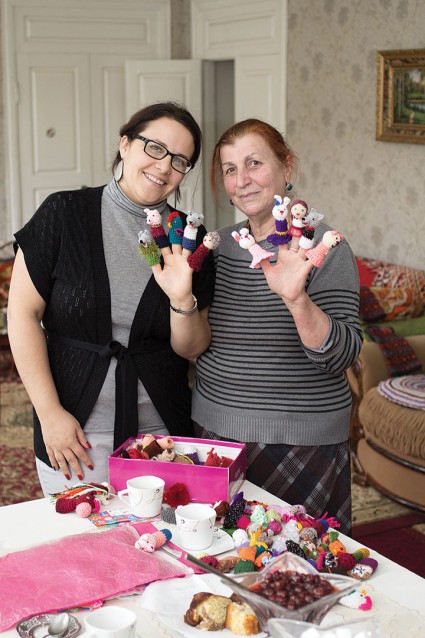 Teresa Hamlin and knitter Sevil show off the fruits of a new finger puppet project. Photo: Tom Marsden
Teresa Hamlin and knitter Sevil show off the fruits of a new finger puppet project. Photo: Tom Marsden
We like red, green and black, Sevil says. The background is mainly black, and we pay special attention to red for patterns. Then we add leaf patterns in green. We use just a little bit of yellow in the middle for highlights, like you see on carpets… We can also use a little blue, maybe a stripe around the edge. Maybe the preference for black came from the abundance of walnuts in the region which were historically used to make dye.
Where brides never get cold feet
The tradition of making jorabs in Qusar has been preserved through generations because the socks are given as part of each bride’s dowry. When a young lady moves into her husband’s home, she gives her mother-in-law a dozen or more pairs of hand-knit socks as gifts for the new family. Narmina explains: I have two daughters-in-law. Each one brought 14 or 15 pairs of socks when she moved in. I give those as gifts to people, like when we have guests from Baku. When young people come visit us I loan them slippers; we have a lot of slippers beside the door for guests to wear. But when I see that an older person has come wearing thin pantyhose, or looks like someone with cold feet, I give them a pair of jorabs to wear and sometimes to keep.
Jorabs can be found for sale at the local market, but in talking to local women, one gets the sense that the bulk of the local knitting is driven more by the tradition of dowries and giving family gifts than by commercial interest. Narmina says, Before I started knitting for Azerbaijani Socks, I just made socks for my family: for my children and grandchildren. My son-in-law in Baku always has cold feet and he wants me to make him new socks every winter.
Her mother, back in cold Minnesota, had worn out her socks and wanted more
Perhaps the scale of Lezgin knitting will evolve as the global demand for their prized socks increases. The socks themselves have already evolved to keep up with the times. Sevil explains, People used to knit tall [calf-length] jorabs. When we went out of the house, we could wear them with our [low-top] galoshes to keep our ankles warm. Now tall boots are more popular, so we don’t need such high socks to keep warm. Now we knit more ankle-length socks just to wear around the house. Tellingly, locals often refer to these low socks as domashniki, a borrowed Russian word for house slippers.
We visit a home where three middle-aged sisters show off their knitting prowess. Their grandmother was a carpet maker, and it seems they have textile arts in their genes. One of their daughters, still in eighth grade, is the youngest of the knitters for Azerbaijani Socks. She keeps some of her earnings for pocket money but gives most of them to her mother. I ask if her classmates are interested in knitting, but she shakes her head.
One of her neighbours comments, If a girl wants to learn how to knit, she will. I hope my future daughters-in-law will want me to teach them… not a lot of young people actively knit. But they should at least know how; they will need this for their future. It’s a good thing to keep yourself occupied when you’re sitting around.
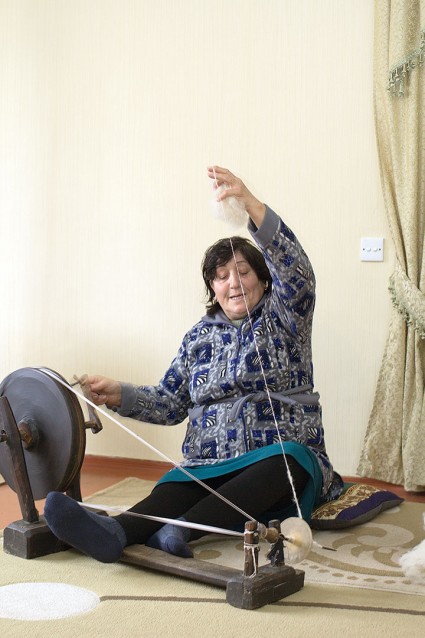 A local woman demonstrates a traditional spinning wheel which is still occasionally used in the region. Photo: Tom Marsden
A local woman demonstrates a traditional spinning wheel which is still occasionally used in the region. Photo: Tom Marsden
Wild and woolly business beginnings
Are Lezgin jorabs in danger of extinction? Not according to the knitters, and certainly not if Teresa has anything to do with it. She now provides employment for 26 knitters, but the business grew organically. Teresa, an American and long-time resident of Azerbaijan, fell in love with Qusar after many visits and finally moved there in 2012 to teach English at the Shahdagh ski resort. Then her parents came to visit her, and someone gave them a pair of hand-knit socks as a souvenir. It wasn’t long before her mother, back in cold Minnesota, had worn out her socks and wanted more. She said, can you bring me some more of those socks? It was interesting to me because in America, she could have bought any other kind of socks she wanted. Other expat friends in Baku also asked Teresa if she knew someone who could knit socks for them, and she began to sense the demand.
Teresa liked the traditional jorab patterns available at the local bazar, but felt that the colours could be made more compatible with Western tastes, and she didn’t care for the scratchy natural wool. She eventually decided to bring softer yarn to some Lezgin knitters and commission them to make socks with simpler colour schemes for American consumers. She started with just 100 socks the first winter. She says, I didn’t start intending to make this a social enterprise and have a website and everything... I didn’t know if there would be a big interest in the socks. Last winter was my first big “send them to America and see how they sell” year. But they did well.
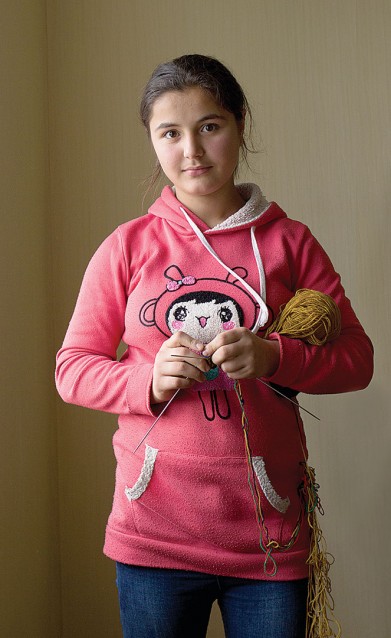 Marina, the youngest knitter for Azerbaijani Socks, works with her mother and aunts. Photo: Tom Marsden
Marina, the youngest knitter for Azerbaijani Socks, works with her mother and aunts. Photo: Tom Marsden
Now the business has grown to include Fair Trade stores and boutiques around the USA. It also sells socks online through Etsy. Despite the growth, Teresa hopes to maintain the business’s personal touch, so every pair of socks bears a tag signed by the woman who knitted it. Buyers can also read the knitters’ personal stories on the business’s website, azerbaijanisocks.com. Azerbaijani Socks has also branched out beyond socks; they now sell mini sock keychains, fingerless gloves, tea cosies and finger puppets. (In fact, during our visit one of the knitters was working hard to complete a large special order of unicorn finger puppets destined for the States!)
And what does Teresa think about the connection between socks and carpets?
It’s true. When I try to sell in the States, people often ask me if the socks have non-skid surfaces on the bottom for their wood floors.
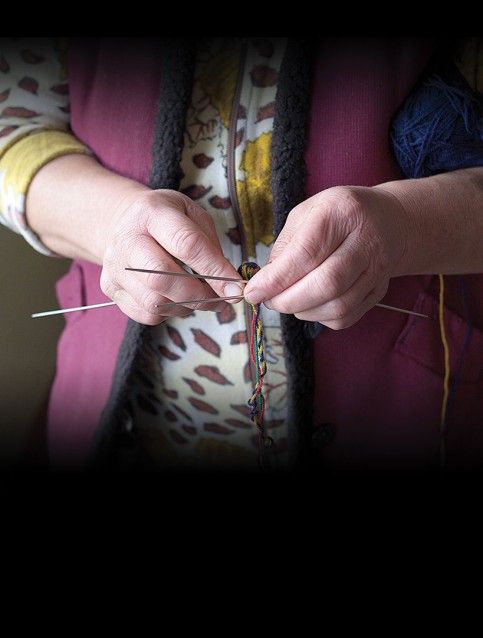
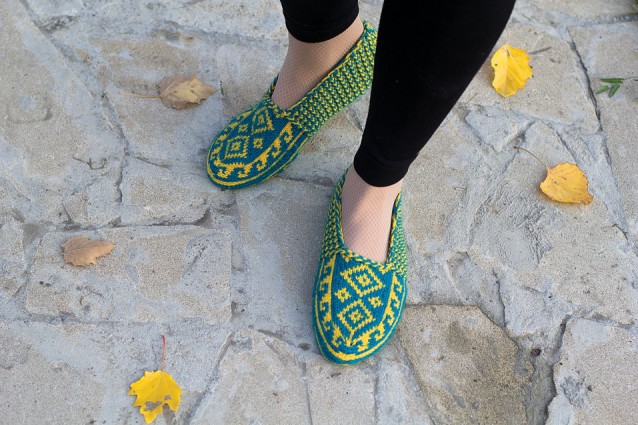


.jpg)